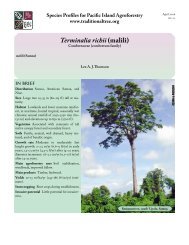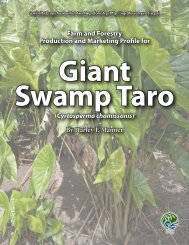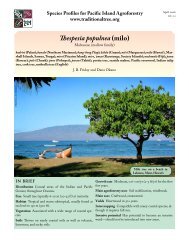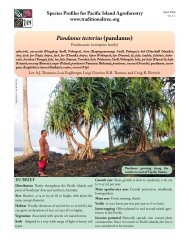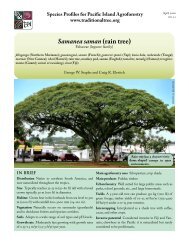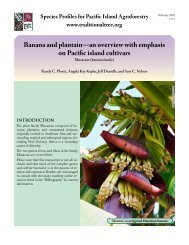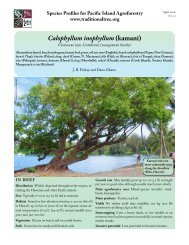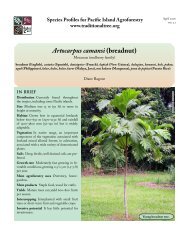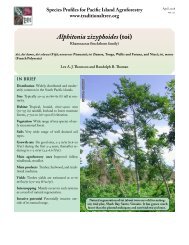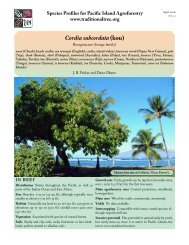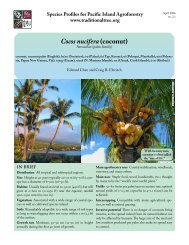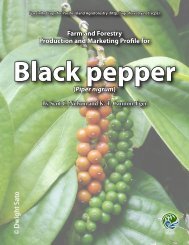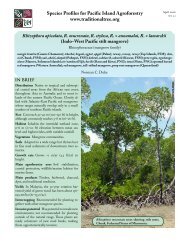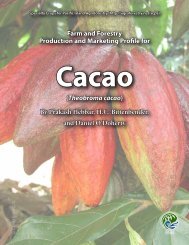Aleurites moluccana (Kukui) - Agroforestry Net
Aleurites moluccana (Kukui) - Agroforestry Net
Aleurites moluccana (Kukui) - Agroforestry Net
You also want an ePaper? Increase the reach of your titles
YUMPU automatically turns print PDFs into web optimized ePapers that Google loves.
To improve the germination rate, bad seeds can be floated<br />
off in water.<br />
Seed storage<br />
Seeds can be stored for several months when dried to<br />
10–12% moisture content. Often seeds lying on the ground<br />
under trees are viable and can be used successfully.<br />
Pre-planting treatments<br />
Untreated seeds germinate in about 4 months. Sun warming<br />
of a moist medium is thought to hasten and improve<br />
germination. Cracking the seed coat (shell) and soaking<br />
overnight in water may also hasten germination. Fungi<br />
growing on the seed coat may become a problem for germinating<br />
seeds, so treating the seeds with a fungicide prior<br />
to sowing may be helpful in reducing fungal problems.<br />
Seed scarification with acid does not benefit germination.<br />
Growing area<br />
<strong>Kukui</strong> seeds can grow in moderate shade, but full sun also<br />
works and may hasten germination.<br />
Germination<br />
Seeds can be direct-seeded in containers or pregerminated<br />
in beds. When seeds are pregerminated in a bed, it is best to<br />
transplant the seeds just as they begin to germinate when<br />
the seed cracks open. Pregerminated seeds can either be<br />
planted in nursery containers or direct-sown in the field.<br />
Media<br />
Because kukui germinants have a large, thick taproot, it is<br />
recommended that seedlings are grown in 2–4 liter (1/2–1<br />
gallon) root-training containers. Use a well drained potting<br />
medium such as 50% peat moss, 25% perlite, and 25%<br />
vermiculite, amended with a little compost, dolomite lime,<br />
gypsum, and 14–14–14 slow-release fertilizer. Potting media<br />
should also be inoculated with mycorrhizal fungi from<br />
a reputable commercial source, particularly if the trees will<br />
be planted in degraded soils.<br />
Time to outplanting<br />
After germination, plants are ready to be transplanted into<br />
the field after about 3–4 months.<br />
Approximate size for outplanting<br />
Trees are ready to outplant when they have attained a<br />
height of about 25 cm (10 in) and stem diameter of 12 mm<br />
(0.5 in).<br />
<strong>Aleurites</strong> <strong>moluccana</strong> (kukui)<br />
Guidelines for outplanting<br />
It has been reported that 200–300 seedlings are planted<br />
per hectare for oil seed production. In windbreaks, kukui<br />
can be planted 3–4 m (10–13 ft) apart in the row.<br />
DISADVANTAGES<br />
There are very few disadvantages to planting the widely<br />
adapted and multipurpose kukui tree. Perhaps the biggest<br />
commercial disadvantage is that no large markets exist for<br />
any kukui products. Also, it is so easy to grow in many<br />
environments that there is no clear commercial advantage<br />
to growing it in any specific place. For example, any kukui<br />
product that can be produced in Hawai‘i can be easily reproduced<br />
in other tropical regions where the costs of land<br />
and labor are cheaper.<br />
Potential for invasiveness<br />
<strong>Kukui</strong> has naturalized in several Pacific islands, particularly<br />
in Hawai‘i, and has the potential to become established<br />
outside of cultivation. Despite this, kukui is rarely considered<br />
a harmful invasive or pest species.<br />
Susceptibility to pests/pathogens<br />
The following fungi are known to attack kukui: Cephalosporium<br />
sp., Clitocybe tabescens, Fomes hawaiensis, Gloeosporium<br />
aleuriticum, Physalospora rhodina, Polyporus gilvus, Pythium<br />
ultimum, Sclerotium rolfsii, Sphaeronema reinkingii, Trametes<br />
corrugata, Xylaria curta, Ustulina deusta. Nematodes<br />
include Meloidogyne sp. (Duke 1983).<br />
AGROFORESTRY/ENVIRONMENTAL<br />
PRACTICES<br />
Mulch/organic matter<br />
<strong>Kukui</strong> leaves make a good mulch. To preserve the health<br />
of the tree and encourage rapid regrowth, only a small percentage<br />
of the leaves (less than 20%) should be removed at<br />
any one time.<br />
Soil stabilization<br />
<strong>Kukui</strong> grows well on steep slopes and in gulches. Along<br />
with koa (Acacia koa), kukui was one of the first trees<br />
planted by the Hawai‘i Division of Forestry for watershed<br />
rehabilitation.<br />
Crop shade/overstory<br />
Although not considered overly competitive with other<br />
plants, kukui’s dense shade limits its use as shade for lightdemanding<br />
crops.



